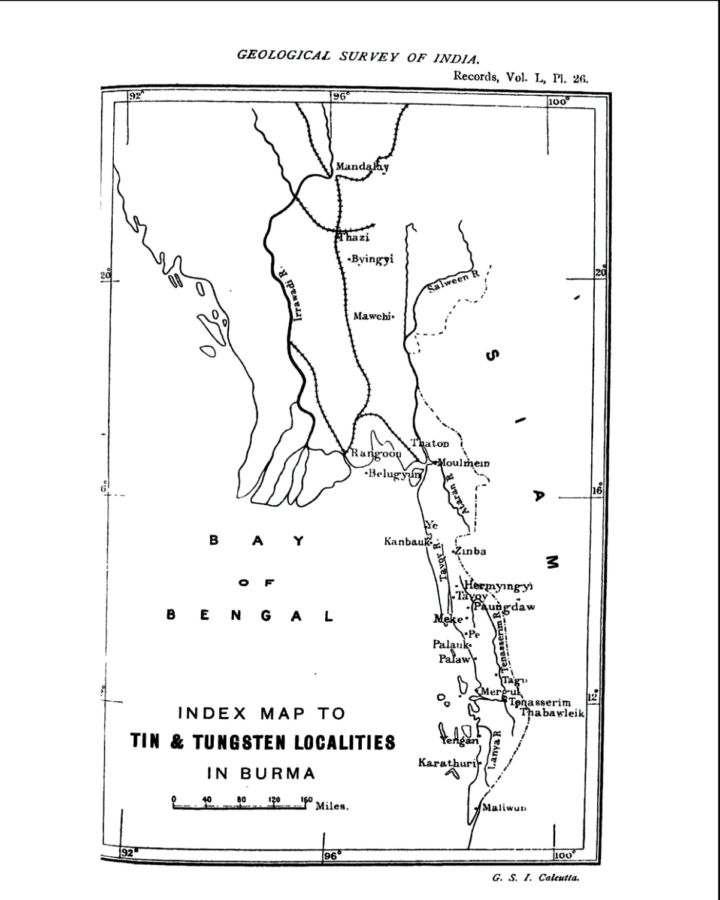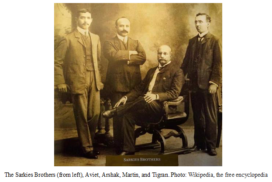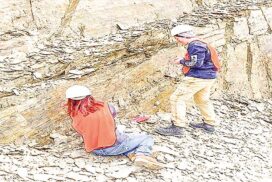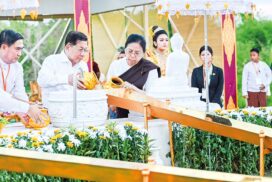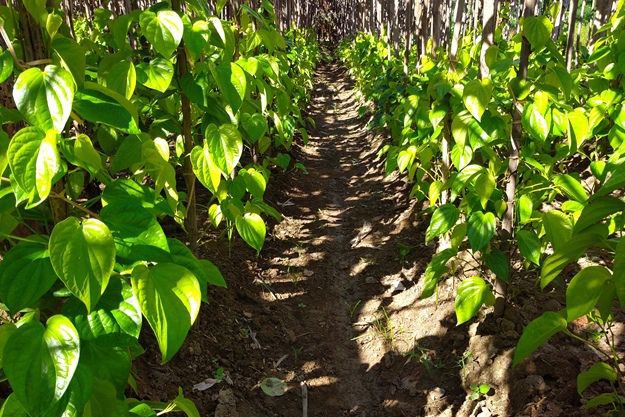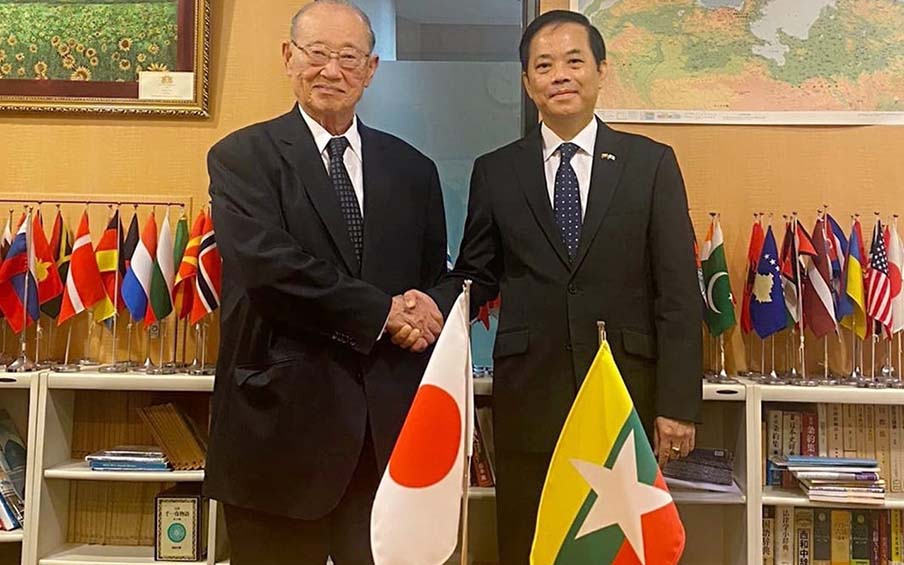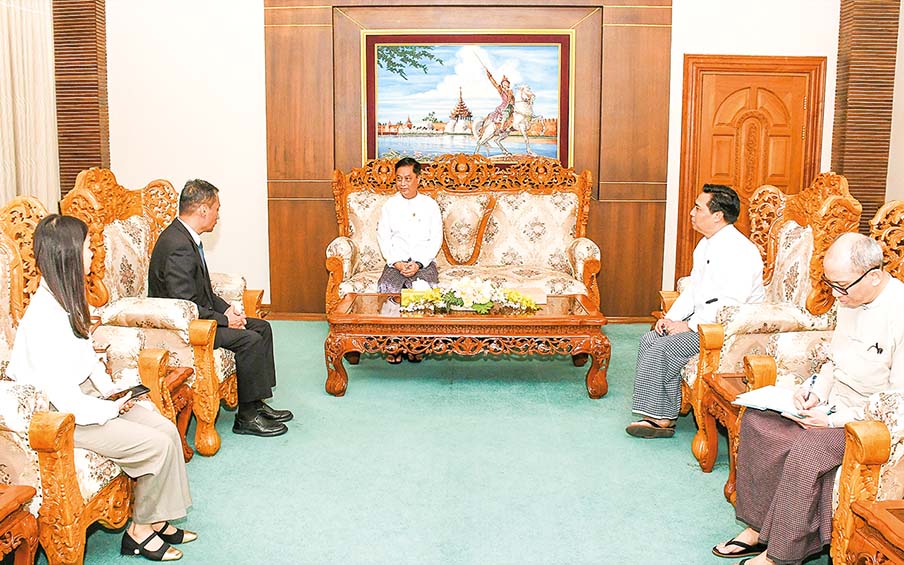By THAN HTUN (GEOSCIENCE MYANMAR)
EPISODE:15
John Coggin Brown (1884-1962) was educated at King James I School, Bishop Auckland, and entered Armstrong College, University of Durham, in 1901 as a science student. He graduated in 1904 with honours in geology and chemistry and gained medal awards and a scholarship in mineralogy and inorganic chemistry for his original work. He was awarded the MSc degree from Durham University in geology in 1911 and later received the doctorate. In 1905 Dr Brown left England for India on his appointment as an Assistant Superintendent in the Geological Survey of India. After a short period in the laboratory, he was deputed to the Western Himalayas in 1906 and later in the year to the Northern Shan States of Burma. He was sent in 1907 to the Province of Yunnan in Western China and received a promotion for his work there. He moved between Calcutta, Assam, Burma, and Yunnan over the period 1908-1913, his reports in Burma covered quarry products for road metal, the oil, coal, and iron fields, the Bawdwin mines, and ore deposits, inquiries into a bridge site across the Irrawaddy and on earthquakes; he reported on gold-bearing deposits of Mong-long and advised on boring for oil below the bed of Irrawaddy.
In Yunnan, he was concerned with mines and mineral deposits, and in Assam with oil and coal particularly and with a landslip investigation. He was appointed Government Geologist in Burma, and the first official member of the Burma Oilfields Advisory Board. For his service as a geologist with the Abor Expeditionary Field Force in 1913 he was awarded the Indian General Service Medal. He visited Southern India between tours in Burma. In December 1913, he was appointed Curator, of the Geological Survey of India, and lecturer in geology, at Presidency College, Bengal, and a Special lecturer in economic geology of India at Calcutta University.
During the 1914-18 war he was the resident mining adviser to the Government in connection with efforts to increase the output of Wolfram and was sent to Tavoy. He was made Inspector of Mines in Burma and Inspector of Explosives. He received the OBE for his war work. He left Tavoy in 1919 on deputation to London as India’s representative on the Imperial Mineral Resources Bureau and as Minerals Adviser to the Indian authorities in London.
Dr Brown returned to India in 1922 and was placed in charge of the office of the Geological Survey of India in Calcutta for some time before his appointment as Superintendent of the Burma Party of the Geological Survey of India, and held this post until his retirement in 1934. Since 1932 he had been a consulting mining geologist, and he served on the Cochin Harbour Committee in 1938. He had lived in England since his retirement from the Survey. He made many valuable contributions to the Records and Memoirs of the Geological Survey of India and wrote from his wide knowledge of minerals for the technical press. He was the author of the book entitled India’s mineral wealth: a guide to the Occurrences and Economics of useful minerals of the Indian Empire (first edition 1923, second edition 1936, and third edition, revised, jointly with A K Dey, 1955, published by Oxford University Press). John Coggin Brown died on 23 June 1962, at the age of 77.
Mr Brown reported “The Cassiterite Deposits of Tavoy” in Part 1, Volume XLIX of Records of the Geological Survey of India in 1919. The significant points of his report are extracted below: –
The Cassiterite Deposits of Tavoy
In a paper submitted to the Geological Section of the Indian Science Congress in 1916, I discussed the origin of the wolfram and cassiterite-bearing quartz loads of the Tavoy district in lower Burma, one of the more important wolfram mining centres of the world. It was pointed out therein that the sedimentary rocks of the Mergui Series, which from the greater part of Southern Tenasserim, have been pierced by great intrusions of acid granites, and that the final phases of the intrusions were distinguished by the formation of pegmatites, aplites, quartz lodes and segregations, greisens, and quartz porphyries, possessing a roughly peripheral disposition around the parent masses. The granites contain cassiterite, wolfram, and molybdenite as accessory minerals. The pegmatite veins and quartz lodes contain wolfram, cassiterite, scheelite in small quantities, native bismuth, bismuthinite, and sulphides of iron, copper, arsenic, antimony, lead, and zinc. Gold is found in the placer deposits of the district and probably comes from the lodes, but it has not been discovered in situ up to date. The objective of the paper is to bring together a few observations on the presence of tin ore in Tavoy.
History
The date of the beginning of tin mining in Tavoy is lost in obscurity, but judging from the extent and character of the ancient workings, it must have been carried on for a very long time.
Tavoy became part of the British Empire in 1825. As early as 1836, Captain Low published a list of tin mines and stated that they found employment for 400 Burmese during 4 months of the year.
In 1839, Dr Helfer published the results of his travels in Ye, Tavoy, and Mergui. He came across tin-stone workings 40 feet deep in alluvium near Myitta and discovered a cassiterite lode near Wunpo. This place is probably the modern Egani, where extensive ancient workings have been found recently.
In 1842, an anonymous writer mentioned the occurrence of cassiterite in the Talaingya and Taungbyuk chaungs.
In 1849, O’Riley published a paper dealing with the metalliferous deposits of Tenasserim in which a list of tin mines is given, including the Taungbyauk chaung, the headwaters of the Tenasserim and the stream flowing into the Heinze Basin.
About this time a most interesting work appeared by Dr Mason, one of the early American missionaries in Lower Burma. It is an encyclopedic account of the natural history of Tenasserim, with a portion devoted to geology and mineralogy. In it, I have found the earliest reference to Tavoy Wolfram with which I am acquainted. It also contains a brief description of certain tin mines in Mergui. According to Dr Mason, “Tin is abundant in the provinces, commencing from the mountains in which Tavoy and Heinze’s rivers have their rise, the northern limit of tin in the provinces, to the southern boundary of Mergui, Pakchan River. The richest locality in the province of Tavoy is nearly opposite the city of Tavoy on the eastern side of the mountains.” That large quantities of tin must have been found in Tavoy three hundred years ago, we have evidence in an incidental remark of Mr Ralph Fitch; who, says Mr Hough in the Moulmein Chronicle, “travelled in this part of the world about the year 1586, or 1587.” He says “I went from Pegu to Malacca passing many of the seaports of Pegu, as Martaban, the Island of Tavi whence all India is supplied with tin, Tenasserim, the Island of Junkselon, and many others.”
In 1852, O’Riley appeared again with statistics of tin mining in Tavoy which were contradicted by Dr T. Oldham, the first Director of the Geological Survey of India, who, some years previously had laid the foundations of our geological knowledge of Tavoy and Mergui. Helfer came on the scene again in 1859, and in 1861samples of tin ore from Heinze, Nwalabo, and Khamaunghla were displayed at an exhibition in London.
In 1905, the Golden Stream Syndicate issued its prospectus. This concern had prospecting rights over an area of 350 square miles including most of Paungdaw and the upper Kamaungthwe valley, but its operations were unsuccessful.
It is possible that indigenous tin mining was almost extinguished during Alompra’s inversion in the middle of the 18th century. It is recorded that, after the Talaings were overthrown in the north, the Emperor marched down the mainland of Tenasserim, while his convoys sailed down the coast.
In 1908, when Mr J J A Page, then an officer of the Geological Survey of India, commenced his inquiry into the conditions of tin mining in Tavoy, the output was barely one ton per annum. In 1909, wolfram was met with in several localities, and from that date production of this mineral has steadily increased.
Occurrence
Cassiterite is found in Tavoy in lodes, in detrital deposits, in placer deposits, and as an original accessory in certain granites.
Lode Deposits: Cassiterite is almost always found in close association with Wolfram. Only one instance is known of a cassiterite-quartz lode that contains no wolfram. Examples of quartz lodes containing wolfram to the almost total exclusion of cassiterite are commoner, but, as a general rule, most of the Tavoy wolfram lodes contain some cassiterite. The associated minerals are nearly all micas with sulphides of iron, copper, molybdenum, lead, bismuth, or zinc, the iron sulphides vastly predominating. Specimens have been collected that show that in some lodes the tin mineral was the first to be deposited, the tungsten compound coming second, but this is very rare; in most examples, tin has clearly followed tungsten. Greisens carrying both wolfram and cassiterite frequently border the mixed lodes when they traverse granite. They furnish a certain proportion of concentrate Cassiterite tends to be more widely disseminated in the greisens than wolfram.
Detrital Deposits: The large portion of the mixed concentrates of Tavoy are won from the detrital deposits of the hillsides during the rainy season. True eluvial deposits are found on the hillsides in which the lodes crop out, and the minerals are washed out by streamlets into the main arteries of surface drainage during rain storms.
Placer Deposits: Wolfram is never found in true placer deposits, although a contrary opinion has often been advanced. It may reach the foot of the hillsides where the eluvial deposits of the slopes merge into the water-sorted ground filling the valley bottoms. When wolfram and cassiterite are broken out of a lode by the action of the weather and begin to travel downhill, the wolfram disappears long before its journey is ended, whereas the tin-stone continues, and is preserved eventually in the alluvial deposits of the valley. The only mineral of commercial importance in the placers of Tavoy is cassiterite.
Recent Deposits: Recent deposits in Tavoy include the modern alluvium which forms the paddy plains, the tidal rivers, and the swamps along their banks. In some of the smaller valleys, the modern alluvium is being derived partly from a re-assortment of the older alluvium deposits.
Sub-recent or Late Tertiary Deposits: They are of great extent and importance, for it is in them that the richer cassiterite placers are likely to occur. They are found as river-terraces raised above the present level of the inland streams; as lacustrine and fluvio-lacustrine deposits laid down in the still waters of the Myitta and other lakes; as deep eluvio-alluvial beds in the submerged basin of Kanbauk and other placers; as clay banks containing the remains of marine animals, and now found raised above the level of the sea in the vicinity of Tavoy estuary. I agree with Mr Heron that the interior regions appear to have undergone a more recent uplift as well. The deposits of the Kanbauk area were accumulated in a rapidly sinking valley which must have stood at a comparatively higher level at one time than it does today.
Origin of the Cassiterite in the Sub-recent Placers: It has been demonstrated recently that both cassiterite and wolfram may exist as original accessory minerals in certain Tavoy granites. This is proved by panning large quantities of decomposed granite obtained in situ. It is possible then to have deposits containing cassiterite and wolfram, without the presence of quartz, lodes, pegmatites, or greisens containing these minerals.
Tin Dredging and its Prospects: A cutter and suction dredge owned by Messrs. Booth and Milne, is operated successfully near Taungthonlon about 30 miles east of Tavoy on the Siam Road. It excavates the old lake deposits which are situated below the modern river gravels, to a depth of 15-20 feet. I may cite the case of the Thingandon flats in the Pauktaing Valley, which are crossed by the most important motor road in the district.
Favourable Localities: Well worth prospecting for deposits of alluvial cassiterite in Tavoy district are: –
(a) the Myitta valley, including the basins of the Ban and Khamaungthwe chaungs and their tributaries, especially the Heinda, Myekhanbaw and Seinpyon chaung;
(b) the upper valley of the Kahmaunghla or Maungmeshaung chaung;
(c) the country around Onhbinkwin and the Heinze Basin;
(d) the gravels of the Zimba chaung;
(e) the alluvial deposits in the upper portion of the Anyapya chaung and its tributaries;
(f) the Thingandon flats of the Pauktaing chaung;
(g) the placer deposits in the vicinity of the Heinze chaung;
(h) the alluvial deposits of the Taungbyauk chaung.
References: J. Coggin Brown, 1919: “The Cassiterite Deposits of Tavoy”, Records of the Geological Survey of India, Part 1, Volume XLIX.

